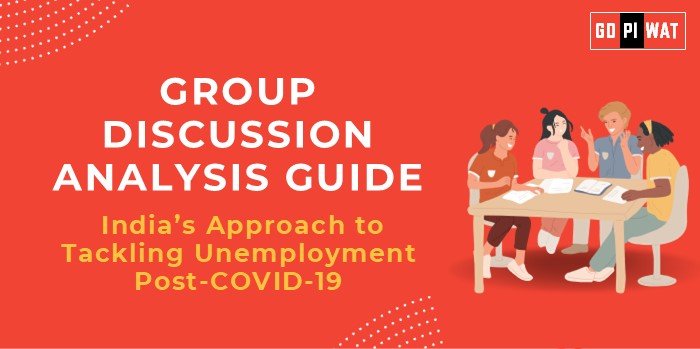📋 Group Discussion (GD) Analysis Guide: India’s Approach to Tackling Unemployment Post-COVID-19
🌐 Introduction to the Topic
Opening Context: The COVID-19 pandemic significantly disrupted India’s labor market, leading to a surge in unemployment and highlighting existing structural challenges. Addressing these issues requires comprehensive policy interventions and innovative solutions.
Background: In April 2020, India’s unemployment rate peaked at 23.5% due to nationwide lockdowns. While subsequent government initiatives aimed at economic recovery, challenges such as job formalization, skill mismatches, and sectoral employment disparities persist.
📊 Quick Facts and Key Statistics
- 📉 Unemployment Peak: 23.5% in April 2020 (CMIE).
- 📈 Current Unemployment Rate: 6.7% in urban areas during January-March 2024 (PLFS).
- 💼 Labor Force Participation Rate (LFPR): 50.2% in urban areas (PLFS).
- 💰 Government Stimulus: ₹27 lakh crore under the Atmanirbhar Bharat package.
- 🛒 Gig Economy Growth: Estimated 7.7 million gig workers in 2023 (NITI Aayog).
👥 Stakeholders and Their Roles
- Government: Formulates policies, implements labor law reforms, and launches skill development programs like PMKVY.
- Private Sector: Drives employment through investments and flexible work models.
- Workers and Unions: Advocate for fair wages and job security.
- NGOs and International Bodies: Support skill development and provide resources for vulnerable communities.
🏆 Achievements and Challenges
Achievements:
- 🛠️ MGNREGA: Provided 3.3 billion person-days of employment in FY 2022-23.
- 🚴 Gig Economy Expansion: Projected to reach 23.5 million workers by 2030 (NITI Aayog).
- 🚀 Start-Up Ecosystem: Over 100 unicorns contributing significantly to job creation.
- 🌱 Rural Livelihood Programs: Empowered self-help groups under the NRLM.
Challenges:
- 🛑 Skill Mismatch: Only 25% of the workforce is formally skilled.
- 📉 Youth Unemployment: 12.9% as of April 2024 (ILO).
- ⚠️ Informal Sector Vulnerability: Approximately 80% of the workforce lacks job security (PLFS).
- 👩💼 Gender Gap: Female labor force participation at 19.9% (World Bank, 2023).
🌍 Global Comparisons
- 🇩🇪 Germany: Vocational training programs reduced youth unemployment to under 6%.
- 🇰🇷 South Korea: Technology-driven job reskilling initiatives successfully addressed automation challenges.
📖 Case Studies:
- 🌟 Kerala: Kudumbashree created over 4 million livelihoods, becoming a model for women-led development.
- 🌾 Odisha: Skilling tribal youth under Skill India increased employability in underserved areas.
📑 Structured Arguments for Discussion
- Supporting Stance: “Government initiatives like MGNREGA and Atmanirbhar Bharat have significantly contributed to employment generation in rural areas.”
- Opposing Stance: “The unemployment rate remains high among youth and women, highlighting gaps in policy execution.”
- Balanced Perspective: “While job creation initiatives have made progress, there is a critical need for deeper reforms in skill training and digital job accessibility.”
🔧 Strategic Analysis of Strengths and Weaknesses
- Strengths: Growing start-up ecosystem, government initiatives, and increasing adoption of digital platforms.
- Weaknesses: Skill mismatches, low formal training levels, and gender disparity.
- Opportunities: Expansion of AI-driven industries, green jobs, and public-private partnerships.
- Threats: Automation-induced job displacement and global economic slowdown.
🎓 Connecting with B-School Applications
- Real-World Applications: Aligns with HR management, public policy, and operations strategy courses.
- Sample Interview Questions:
- “What are your thoughts on the gig economy as a solution to unemployment in India?”
- “How can India learn from Germany’s vocational training model?”
- Insights: Focus on job formalization, digitalization, and the impact of technology on employment.


